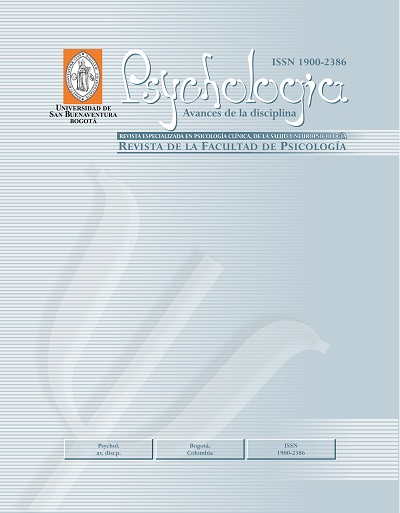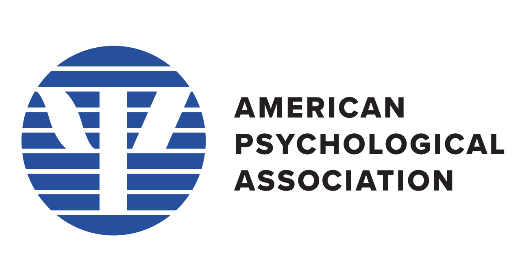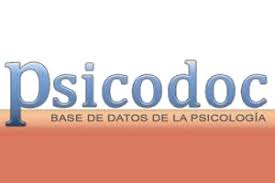View/Download
How to Cite
Pardo Cebrian, R., Fernández-Marcos, T., & Lozano Herrera, T. (2017). Epidemiological study of headache in Spanish university population. Psychologia, 11(2), 13–27. https://doi.org/10.21500/19002386.2785
More Citation Formats
License terms
▼
This journal provides open, immediate access to its contents, based on the principle that offering the public free access to research helps to promote a higher global exchange of knowledge.
As such, all journal articles are published under a Creative Commons Attribution-NonCommercial-ShareAlike 4.0 International License (CC BY-NC-SA), by which commercial use of the original work or its possible derived works is not allowed, and the distribution thereof must be done with the same license elements regulating the original work.
http://creativecommons.org/licenses/by-nc-sa/4.0/
Abstract
Headaches represent a major socio-sanitary problem due to its high global prevalence and the important implications that they have on quality of life. Stress is an essential factor in the development and maintenance of headaches, a problem frequently encountered in university students. This study analyzes the prevalence, frequency, duration, intensity, diagnosis, medication and distribution of headaches as well as other epidemiological characteristics related to perceived disability and coping strategies. A sample of 458 participants formed by 306 students from the Autonoma University of Madrid (UAM) and 152 people not related to that university completed the "Online Headaches Epidemiological Inquest" created ad hoc for this study. We found a high percentage of people who presented headaches frequently (between 5 and 20 times per month) and were not diagnosed (63.2%). The results are compared with data obtained from other populations and their impact and implications are discussed. The need to implement psychological and multidisciplinary prevention and treatment programs is highlighted.
Keywords:
References
Bayram, N. y Bilgel, N. (2008). The prevalence and socio-demographic correlations of depression, anxiety and stress among a group of university students. Social psychiatry and psychiatric epidemiology, 43(8), 667-672. 10.1007/s00127-008-0345-x
Belvís, R., Mas, N., y Roig, C. (2015). Novedades en la reciente Clasificación Internacional de las Cefaleas: clasificación ICHD-III beta. Revista de Neurología, 60(2), 81-89.
Bigal, M. E., Bigal, J. M., Betti, M., Bordini, C. A., y Speciali, J. G. (2001). Evaluation of the impact of migraine and episodic tension‐type headache on the quality of life and performance of a university student population. Headache: The Journal of Head and Face Pain, 41(7), 710-719. 10.1046/j.1526-4610.2001.041007710.x
Britton, C. B. (2012). Stress and headache. En M. Green y P. Muskin, The Neuropsychiatry of Headache, (pp. 54–62) Cambridge University Press doi:10.1017/cbo9781139206952.007
Buonanotte, C., Fernández, A. y Enders, J. (2008). Impacto de la migraña en estudiantes universitarios. Migrâneas cefaléias, 11(4), 225-228.
Buse, D. C., y Lipton, R. B. (2015). Primary headache: What’s stress got to do with it? Cephalalgia, 35 (10), 844-849. 10.1177/0333102414567382
Bussone, G., Grazzi, L., y Panerai, A. E. (2012). Pain, emotion, headache. Headache: The Journal Of Head And Face Pain, 52 (2), 98-101. doi:10.1111/j.1526-4610.2012.02244.x
Cano, F. J. (2001). Variables psicológicas implicadas en la migraña y cefalea tensional. Un estudio comparativo con otros trastornos por dolor crónico. (Tesis doctoral no publicada). Universidad de Sevilla.
Cardona, A., y Santacreu, J. (1984). Modelos explicativos de las enfermedades psicosomáticas: la dificultad de habituación de la respuesta como factor precipitante. Revista Española de Terapia del Comportamiento, 2(1), 17-37.
Combes, J., Sarubbi De Rearte, E., Castaldo, R. I., y Chirre, A. E. (2014). Estrés y cefaleas vasculares en estudiantes universitarios. En VI Congreso Internacional de Investigación y Práctica Profesional en Psicología XXI Jornadas de Investigación Décimo Encuentro de Investigadores en Psicología del MERCOSUR. Facultad de Psicología-Universidad de Buenos Aires.
Dureja, G. P., Jain, P. N., Shetty, N., Mandal, S. P., Prabhoo, R., Joshi, M., y ... Phansalkar, A. A. (2014). Prevalence of chronic pain, impact on daily life, and treatment practices in India. Pain Practice, 14(2) E51-E62. 10.1111/papr.12132
Fernández C. y Canuet, L. (2003). Discapacidad y calidad de vida en pacientes con migraña: factores determinantes. Rev Neurol, 36 (1105), 12.
Ferrante, T., Manzoni, G. C., Russo, M., Camarda, C., Taga, A., Veronesi, L. y Torelli, P. (2013). Prevalence of tension-type headache in adult general population: The PACE study and review of the literature. Neurological Sciences, 34 (1) 137-138. 10.1007/s10072-013-1370-4
Giaccone, M., Baratta, F., Allais, G., y Brusa, P. (2014). Prevention, education and information: the role of the community pharmacist in the management of headaches. Neurological Sciences, 35(1), 1-4. 10.1007/s10072-014-1732-6
Gil-Gouveia, R., Oliveira, A. G., y Martins, I. P. (2015). Assessment of cognitive dysfunction during migraine attacks: a systematic review. Journal of neurology, 262(3), 654-665. 10.1007/s00415-014-7603-5
Glombiewski, J. A., Hartwich-Tersek, J., y Rief, W. (2010). Two psychological interventions are effective in severely disabled, chronic back pain patients: A randomised controlled trial. International Journal of Behavioral Medicine, 17(2), 97-107. 10.1007/s12529-009-9070-4
González, M. L., y Vives, J. F. (2015). Estrés psicológico y problemática musculoesquelética. Revisión sistemática. Enfermería Global, 14(2), 276-300. 10.6018/eglobal.14.2.194561
Grande, R. B., Aaseth, K., Benth, J. Š., Lundqvist, C., y Russell, M. B. (2011). Reduction in medication-overuse headache after short information. The Akershus study of chronic headache. European Journal Of Neurology 18(1), 129-13.10.1111/j.1468-1331.2010.03094.x
Hassan, S., Muere, A., y Einstein, G. (2014). Ovarian hormones and chronic pain: A comprehensive review. Pain, 155(12), 2448-2460. 10.1016/j.pain.2014.08.027
Herrero, M. T. V., García, M. J. T., Iñiguez de la Torre, M. V. R., y García, L. M. C. (2014). Repercusión de las cefaleas sobre la incapacidad laboral en España. Revista CES Salud Pública, 6 (4), 199-206. 10.1016/j.neuarg.2014.05.003
Jensen, R., y Stovner, L. J. (2008). Epidemiology and comorbidity of headache. The Lancet Neurology, 7(4), 354-361. 10.1016/S1474-4422(08)70062-0
Katsarava, Z., y Obermann, M. (2013). Medication overuse headache. Topics in Pain Management, 29(2), 1-7. 10.1097/01.tpm.0000434247.92392.ef
Kikuchi, H., Yoshiuchi, K., Ando, T., y Yamamoto, Y. (2015). Influence of psychological factors on acute exacerbation of tension-type headache: Investigation by ecological momentary assessment. Journal of psychosomatic research, 79(3), 239-242. 10.1016/j.jpsychores.2015.06.008
Kurt, S., y Kaplan, Y. (2008). Epidemiological and clinical characteristics of headache in university students. Clinical neurology and neurosurgery, 110(1), 46-50. 10.1016/j.clineuro.2007.09.001
Labrador, F. J., y de la Fuente, M. L. (1988). Tratamiento de las cefaleas funcionales: consideraciones actuales y propuesta de intervención. Anuario de psicología/The UB Journal of psychology, 38, 67-86.
Litt, M. D., y Tennen, H. (2015). What are the Most Effective Coping Strategies for Managing Chronic Pain? Pain Management, 5(6), 403–406. 10.2217/pmt.15.45
Melzack, R., y Katz, J. (2013). Pain. Wiley Interdisciplinary Reviews: Cognitive Science, 4(1), 1–15. 10.1002/wcs.1201
Melzack, R., y Wall, P. D. (1965). Pain Mechanisms: A New Theory. Science, 150(3699), 971–978. 10.1126/science.150.3699.971
Ministerio de Sanidad, Servicios Sociales e Igualdad y el Instituto Nacional de Estadística. Cuestionario Nacional de Salud en España (2011-2012).
Miró J. (2003). Dolor crónico: procedimientos de evaluación e intervención psicológica. Bilbao: Desclée de Brouwer.
Moix, J., Cañellas, M., Girvent, F., Martos, A., Ortigosa, L., Sánchez, C., y Portell, M. (2004). Confirmación de la eficacia de un programa educativo interdisciplinar en pacientes con dolor de espalda crónico. Revista de la Sociedad Española del Dolor, 11(3), 141-149.
National Institute for Health and Care Excellence (2012). Headaches: diagnosis and management of headaches in young people and adults. Clinical Guideline 150. Disponible en guidance.nice.org.uk/cg150.
Pal, S. G., Delgado, E. G., Mendoza, J. Q., y de los Ángeles Fernández, M. (2008). Características psicopatológicas en un grupo de pacientes con cefalea. Psicologia. com, 12(1).
Pardo A. y San Martín R. (2015). Análisis de datos en ciencias sociales y de la salud (vol II, 2ª ed.). Madrid: Síntesis
Raak, R., y Wahren, L. K. (2005). Headache and coping in a female working population. Scandinavian Journal Of Caring Sciences, 19(4), 325-329. doi:10.1111/j.1471-6712.2005.00347.x
Ramírez-Maestre, C., Esteve, R., y López, A. E. (2008). Cognitive appraisal and coping in chronic pain patients. European Journal of Pain, 12(6), 749–756. 10.1016/j.ejpain.2007.11.004
Raña, N. (2008). Migraña en la mujer. Rev Neurol, 46 (373), 8.
Sánchez, F. M., y Hernández, A. S. (1992). Prevalencia de cefaleas en una población universitaria. Rev San Hig Púb, 66, 313-317.
Snow, J., y Mann, M. (2013). Qualtrics survey software: handbook for research professionals. Qualtrics Labs, Inc.
Steiner, T. J., Stovner, L. J., Katsarava, Z., Lainez, J. M., Lampl, C., Lantéri-Minet, M., ... y Andrée, C. (2014). The impact of headache in Europe: principal results of the Eurolight project. J Headache Pain, 15(1), 31. 10.1186/1129-2377-15-31
Stovner, L. J., Zwart, J. A., Hagen, K., Terwindt, G. M., y Pascual, J. (2006). Epidemiology of headache in Europe. European journal of neurology, 13(4), 333-345. 10.1111/j.1468-1331.2006.01184.x
Stovner, L., Hagen, K., Jensen, R., Katsarava, Z., Lipton, R., Scher, A., y ... Zwart, J. (2007). The global burden of headache: a documentation of headache prevalence and disability worldwide.
Cephalalgia: An International Journal Of Headache, 27(3), 193-210. 10.1111/j.1468-2982.2007.01288.x
Tüzün, E. H., Eker, L., Karaduman, A., y Bayramoğlu, M. (2013). Prevalence and clinical characteristics of headache in university students in Turkey. The Pain Clinic. 10.1163/156856903770196764
Wang, X., Zhou, H. B., Sun, J. M., Xing, Y. H., Zhu, Y. L., y Zhao, Y. S. (2016). The prevalence of migraine in university students: A systematic review and meta‐analysis. European Journal Of Neurology, 23(3), 464-475. doi:10.1111/ene.12784
World Health Organization. (2011). Atlas of headache disorders and resources in the world 2011. World Health Organisation.
World Health Organization. (2013). World Health Statistic 2013. www.who.int
Zavala, H., y Saravia, B. (2003). Epidemiología e impacto socioeconómico de la migraña. Revista Argentina de Neurocirugía, 28(2), 79-84.
Zebenholzer K, Andree C, Lechner A, Broessner G, Lampl C, Luthringshausen G, Wuschitz A, Obmann SM, Berek K, Wöber C (2015) Prevalence, management and burden of episodic and chronic headache a cross-sectional multicenter study in eight Austrian headache centres. The Journal of Headache Pain 16(1). 10.1186/s10194-015-0531-7
Belvís, R., Mas, N., y Roig, C. (2015). Novedades en la reciente Clasificación Internacional de las Cefaleas: clasificación ICHD-III beta. Revista de Neurología, 60(2), 81-89.
Bigal, M. E., Bigal, J. M., Betti, M., Bordini, C. A., y Speciali, J. G. (2001). Evaluation of the impact of migraine and episodic tension‐type headache on the quality of life and performance of a university student population. Headache: The Journal of Head and Face Pain, 41(7), 710-719. 10.1046/j.1526-4610.2001.041007710.x
Britton, C. B. (2012). Stress and headache. En M. Green y P. Muskin, The Neuropsychiatry of Headache, (pp. 54–62) Cambridge University Press doi:10.1017/cbo9781139206952.007
Buonanotte, C., Fernández, A. y Enders, J. (2008). Impacto de la migraña en estudiantes universitarios. Migrâneas cefaléias, 11(4), 225-228.
Buse, D. C., y Lipton, R. B. (2015). Primary headache: What’s stress got to do with it? Cephalalgia, 35 (10), 844-849. 10.1177/0333102414567382
Bussone, G., Grazzi, L., y Panerai, A. E. (2012). Pain, emotion, headache. Headache: The Journal Of Head And Face Pain, 52 (2), 98-101. doi:10.1111/j.1526-4610.2012.02244.x
Cano, F. J. (2001). Variables psicológicas implicadas en la migraña y cefalea tensional. Un estudio comparativo con otros trastornos por dolor crónico. (Tesis doctoral no publicada). Universidad de Sevilla.
Cardona, A., y Santacreu, J. (1984). Modelos explicativos de las enfermedades psicosomáticas: la dificultad de habituación de la respuesta como factor precipitante. Revista Española de Terapia del Comportamiento, 2(1), 17-37.
Combes, J., Sarubbi De Rearte, E., Castaldo, R. I., y Chirre, A. E. (2014). Estrés y cefaleas vasculares en estudiantes universitarios. En VI Congreso Internacional de Investigación y Práctica Profesional en Psicología XXI Jornadas de Investigación Décimo Encuentro de Investigadores en Psicología del MERCOSUR. Facultad de Psicología-Universidad de Buenos Aires.
Dureja, G. P., Jain, P. N., Shetty, N., Mandal, S. P., Prabhoo, R., Joshi, M., y ... Phansalkar, A. A. (2014). Prevalence of chronic pain, impact on daily life, and treatment practices in India. Pain Practice, 14(2) E51-E62. 10.1111/papr.12132
Fernández C. y Canuet, L. (2003). Discapacidad y calidad de vida en pacientes con migraña: factores determinantes. Rev Neurol, 36 (1105), 12.
Ferrante, T., Manzoni, G. C., Russo, M., Camarda, C., Taga, A., Veronesi, L. y Torelli, P. (2013). Prevalence of tension-type headache in adult general population: The PACE study and review of the literature. Neurological Sciences, 34 (1) 137-138. 10.1007/s10072-013-1370-4
Giaccone, M., Baratta, F., Allais, G., y Brusa, P. (2014). Prevention, education and information: the role of the community pharmacist in the management of headaches. Neurological Sciences, 35(1), 1-4. 10.1007/s10072-014-1732-6
Gil-Gouveia, R., Oliveira, A. G., y Martins, I. P. (2015). Assessment of cognitive dysfunction during migraine attacks: a systematic review. Journal of neurology, 262(3), 654-665. 10.1007/s00415-014-7603-5
Glombiewski, J. A., Hartwich-Tersek, J., y Rief, W. (2010). Two psychological interventions are effective in severely disabled, chronic back pain patients: A randomised controlled trial. International Journal of Behavioral Medicine, 17(2), 97-107. 10.1007/s12529-009-9070-4
González, M. L., y Vives, J. F. (2015). Estrés psicológico y problemática musculoesquelética. Revisión sistemática. Enfermería Global, 14(2), 276-300. 10.6018/eglobal.14.2.194561
Grande, R. B., Aaseth, K., Benth, J. Š., Lundqvist, C., y Russell, M. B. (2011). Reduction in medication-overuse headache after short information. The Akershus study of chronic headache. European Journal Of Neurology 18(1), 129-13.10.1111/j.1468-1331.2010.03094.x
Hassan, S., Muere, A., y Einstein, G. (2014). Ovarian hormones and chronic pain: A comprehensive review. Pain, 155(12), 2448-2460. 10.1016/j.pain.2014.08.027
Herrero, M. T. V., García, M. J. T., Iñiguez de la Torre, M. V. R., y García, L. M. C. (2014). Repercusión de las cefaleas sobre la incapacidad laboral en España. Revista CES Salud Pública, 6 (4), 199-206. 10.1016/j.neuarg.2014.05.003
Jensen, R., y Stovner, L. J. (2008). Epidemiology and comorbidity of headache. The Lancet Neurology, 7(4), 354-361. 10.1016/S1474-4422(08)70062-0
Katsarava, Z., y Obermann, M. (2013). Medication overuse headache. Topics in Pain Management, 29(2), 1-7. 10.1097/01.tpm.0000434247.92392.ef
Kikuchi, H., Yoshiuchi, K., Ando, T., y Yamamoto, Y. (2015). Influence of psychological factors on acute exacerbation of tension-type headache: Investigation by ecological momentary assessment. Journal of psychosomatic research, 79(3), 239-242. 10.1016/j.jpsychores.2015.06.008
Kurt, S., y Kaplan, Y. (2008). Epidemiological and clinical characteristics of headache in university students. Clinical neurology and neurosurgery, 110(1), 46-50. 10.1016/j.clineuro.2007.09.001
Labrador, F. J., y de la Fuente, M. L. (1988). Tratamiento de las cefaleas funcionales: consideraciones actuales y propuesta de intervención. Anuario de psicología/The UB Journal of psychology, 38, 67-86.
Litt, M. D., y Tennen, H. (2015). What are the Most Effective Coping Strategies for Managing Chronic Pain? Pain Management, 5(6), 403–406. 10.2217/pmt.15.45
Melzack, R., y Katz, J. (2013). Pain. Wiley Interdisciplinary Reviews: Cognitive Science, 4(1), 1–15. 10.1002/wcs.1201
Melzack, R., y Wall, P. D. (1965). Pain Mechanisms: A New Theory. Science, 150(3699), 971–978. 10.1126/science.150.3699.971
Ministerio de Sanidad, Servicios Sociales e Igualdad y el Instituto Nacional de Estadística. Cuestionario Nacional de Salud en España (2011-2012).
Miró J. (2003). Dolor crónico: procedimientos de evaluación e intervención psicológica. Bilbao: Desclée de Brouwer.
Moix, J., Cañellas, M., Girvent, F., Martos, A., Ortigosa, L., Sánchez, C., y Portell, M. (2004). Confirmación de la eficacia de un programa educativo interdisciplinar en pacientes con dolor de espalda crónico. Revista de la Sociedad Española del Dolor, 11(3), 141-149.
National Institute for Health and Care Excellence (2012). Headaches: diagnosis and management of headaches in young people and adults. Clinical Guideline 150. Disponible en guidance.nice.org.uk/cg150.
Pal, S. G., Delgado, E. G., Mendoza, J. Q., y de los Ángeles Fernández, M. (2008). Características psicopatológicas en un grupo de pacientes con cefalea. Psicologia. com, 12(1).
Pardo A. y San Martín R. (2015). Análisis de datos en ciencias sociales y de la salud (vol II, 2ª ed.). Madrid: Síntesis
Raak, R., y Wahren, L. K. (2005). Headache and coping in a female working population. Scandinavian Journal Of Caring Sciences, 19(4), 325-329. doi:10.1111/j.1471-6712.2005.00347.x
Ramírez-Maestre, C., Esteve, R., y López, A. E. (2008). Cognitive appraisal and coping in chronic pain patients. European Journal of Pain, 12(6), 749–756. 10.1016/j.ejpain.2007.11.004
Raña, N. (2008). Migraña en la mujer. Rev Neurol, 46 (373), 8.
Sánchez, F. M., y Hernández, A. S. (1992). Prevalencia de cefaleas en una población universitaria. Rev San Hig Púb, 66, 313-317.
Snow, J., y Mann, M. (2013). Qualtrics survey software: handbook for research professionals. Qualtrics Labs, Inc.
Steiner, T. J., Stovner, L. J., Katsarava, Z., Lainez, J. M., Lampl, C., Lantéri-Minet, M., ... y Andrée, C. (2014). The impact of headache in Europe: principal results of the Eurolight project. J Headache Pain, 15(1), 31. 10.1186/1129-2377-15-31
Stovner, L. J., Zwart, J. A., Hagen, K., Terwindt, G. M., y Pascual, J. (2006). Epidemiology of headache in Europe. European journal of neurology, 13(4), 333-345. 10.1111/j.1468-1331.2006.01184.x
Stovner, L., Hagen, K., Jensen, R., Katsarava, Z., Lipton, R., Scher, A., y ... Zwart, J. (2007). The global burden of headache: a documentation of headache prevalence and disability worldwide.
Cephalalgia: An International Journal Of Headache, 27(3), 193-210. 10.1111/j.1468-2982.2007.01288.x
Tüzün, E. H., Eker, L., Karaduman, A., y Bayramoğlu, M. (2013). Prevalence and clinical characteristics of headache in university students in Turkey. The Pain Clinic. 10.1163/156856903770196764
Wang, X., Zhou, H. B., Sun, J. M., Xing, Y. H., Zhu, Y. L., y Zhao, Y. S. (2016). The prevalence of migraine in university students: A systematic review and meta‐analysis. European Journal Of Neurology, 23(3), 464-475. doi:10.1111/ene.12784
World Health Organization. (2011). Atlas of headache disorders and resources in the world 2011. World Health Organisation.
World Health Organization. (2013). World Health Statistic 2013. www.who.int
Zavala, H., y Saravia, B. (2003). Epidemiología e impacto socioeconómico de la migraña. Revista Argentina de Neurocirugía, 28(2), 79-84.
Zebenholzer K, Andree C, Lechner A, Broessner G, Lampl C, Luthringshausen G, Wuschitz A, Obmann SM, Berek K, Wöber C (2015) Prevalence, management and burden of episodic and chronic headache a cross-sectional multicenter study in eight Austrian headache centres. The Journal of Headache Pain 16(1). 10.1186/s10194-015-0531-7
Downloads
Download data is not yet available.





















